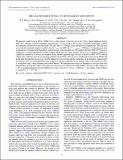| dc.contributor.author | Kraft, Ralph P. | |
| dc.contributor.author | Forman, W. R. | |
| dc.contributor.author | Jones, C. | |
| dc.contributor.author | Nulsen, P. E. J. | |
| dc.contributor.author | Hardcastle, M. J. | |
| dc.contributor.author | Raychaudhury, S. | |
| dc.contributor.author | Sivakoff, G. R. | |
| dc.contributor.author | Sarazin, C. L. | |
| dc.contributor.author | Evans, Daniel A. | |
| dc.date.accessioned | 2015-02-27T14:09:03Z | |
| dc.date.available | 2015-02-27T14:09:03Z | |
| dc.date.issued | 2010-12 | |
| dc.date.submitted | 2010-06 | |
| dc.identifier.issn | 0004-637X | |
| dc.identifier.issn | 1538-4357 | |
| dc.identifier.uri | http://hdl.handle.net/1721.1/95709 | |
| dc.description.abstract | We present results from a 100 ks XMM-Newton observation of the hot gas in the Virgo cluster elliptical galaxy NGC 4472. We find a surface brightness discontinuity ~21 kpc north of the nucleus, consistent with being a contact discontinuity between two moving fluids. We also detect a >60 kpc long ram-pressure stripped tail. The pressure across the discontinuity implies an infall velocity, v [subscript infall], of 1000 km s[superscript -1] < v [subscript infall]< 2200 km s[superscript –1] depending on what assumptions are made about the density and pressure of the external gas. We suggest that the NGC 4472 group is falling into a collapsing filament, which is itself falling into the Virgo cluster. The gas of a collapsing filament is rapidly decelerated as it crosses the standoff shock, but the apparent high velocity of infall for NGC 4472 could be simply due to the fact that the gravitating potential of the NGC 4472 group is unaffected by this shock. While the group falls through the shock its gas will be stripped as it passes through the stalled gas of the filament. Additionally, we find two sets of cool filamentary arms to the east and the southwest of the nucleus. One of the southwest arms is coincident with a sharp filament seen with Chandra. We interpret these arms as filaments of cool gas that have been driven out from the center of the galaxy by the buoyant evolution of a radio bubble. The age of this outburst is ~10[superscript 8] yr assuming that the buoyant bubble rises with a velocity of ~0.4c[subscript s] = 200 km s[superscript –1]; the energy of the outburst is a modest ~2 × 10[superscript 56] erg. | en_US |
| dc.description.sponsorship | United States. National Aeronautics and Space Administration (Grant NAS8-03060) | en_US |
| dc.description.sponsorship | Chandra X-ray Center (U.S.) | en_US |
| dc.description.sponsorship | Smithsonian Astrophysical Observatory | en_US |
| dc.language.iso | en_US | |
| dc.publisher | IOP Publishing | en_US |
| dc.relation.isversionof | http://dx.doi.org/10.1088/0004-637X/727/1/41 | en_US |
| dc.rights | Article is made available in accordance with the publisher's policy and may be subject to US copyright law. Please refer to the publisher's site for terms of use. | en_US |
| dc.source | American Astronomical Society | en_US |
| dc.title | THE GAS DYNAMICS OF NGC 4472 REVEALED BY XMM-NEWTON | en_US |
| dc.type | Article | en_US |
| dc.identifier.citation | Kraft, R. P., W. R. Forman, C. Jones, P. E. J. Nulsen, M. J. Hardcastle, S. Raychaudhury, D. A. Evans, G. R. Sivakoff, and C. L. Sarazin. “THE GAS DYNAMICS OF NGC 4472 REVEALED BY XMM-NEWTON.” The Astrophysical Journal 727, no. 1 (December 30, 2010): 41. © 2011 The American Astronomical Society | en_US |
| dc.contributor.department | MIT Kavli Institute for Astrophysics and Space Research | en_US |
| dc.contributor.mitauthor | Evans, Daniel A. | en_US |
| dc.relation.journal | The Astrophysical Journal | en_US |
| dc.eprint.version | Final published version | en_US |
| dc.type.uri | http://purl.org/eprint/type/JournalArticle | en_US |
| eprint.status | http://purl.org/eprint/status/PeerReviewed | en_US |
| dspace.orderedauthors | Kraft, R. P.; Forman, W. R.; Jones, C.; Nulsen, P. E. J.; Hardcastle, M. J.; Raychaudhury, S.; Evans, D. A.; Sivakoff, G. R.; Sarazin, C. L. | en_US |
| mit.license | PUBLISHER_POLICY | en_US |
| mit.metadata.status | Complete | |
